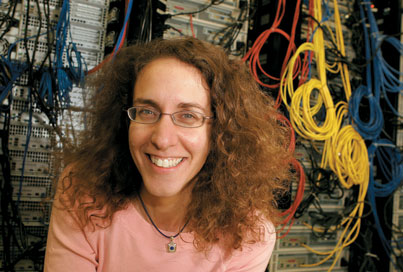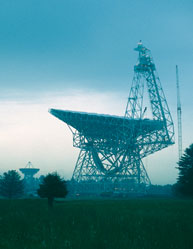By Chris Atack
The discovery of 20 new pulsars confirms theories of star cluster formation

Vicky Kaspi has stars in her eyes. Or more precisely, pulsars – the collapsed remnants of massive stars that emit regular radio or X-ray pulses.
As a physics professor and Canada Research Chair in Observational Astrophysics at McGill University, Kaspi has a particular interest in the pulsars that one day might act as beacons for starships speeding through the dark reaches of interstellar space.
Post-doctoral fellow Scott Ransom led the Kaspi research team’s recent discovery of more than 20 pulsars in a single star cluster in the Milky Way. (Ransom is also an astronomer at the National Radio Astronomy Observatory in Charlottesville, Virginia.) The team’s results were published in the journal Science. The discovery is impressive for several reasons. First, pulsars are notoriously hard to find. Their signals are faint and other stars produce so much “noise” that it’s difficult to pick out individual signals. Powerful computers and huge amounts of data are needed.
Second, their discovery helps confirm a leading theory about the formation of star clusters. “One of our models of star formation predicts this particular cluster should have many, many pulsars in it,” says Kaspi. “But for a long time, we couldn’t find any. By solving the mystery of where all those pulsars are, we validated the model. That’s a relief, because it means theorists don’t have to go back to the drawing board and start all over again.”
To locate pulsars, scientists use radio and X-ray telescopes to search the sky for regular pulsations. They “download” vast quantities of data from the cosmos and then comb through it with supercomputers, looking for regular signals amid the background cosmic buzz.
“Most pulsars emit radio waves, so we search for them with radio telescopes that look just like giant satellite dishes,” Kaspi says. “If you amplify the signals from the telescope, you can sometimes ‘hear’ the pulsar’s signal.
“These signals vary depending on how fast the pulsar is rotating. Some rotate about once a second, while the fastest one rotates over 642 times per second, so its signal actually generates a musical tone. You can plot pulsar signals on the computer and see the beat – like a heartbeat in the sky.”
Kaspi uses radio telescopes on Earth as well as orbiting X-ray telescopes to study pulsars and neutron stars. Data from these observatories are collected and analyzed by her group’s Beowulf mini-supercomputer on the third floor of McGill’s Rutherford Physics Building.

Kaspi’s overall specialty is “compact objects,” a category that includes some of the odder items in the known universe: pulsars, black holes and neutron stars. These objects are formed when stars much more massive than our sun run out of fuel and collapse on themselves.
When the most massive stars collapse, they form black holes, dense concentrations of mass with gravitational fields so powerful that not even light can escape. Because black holes don’t emit light, they can be observed only by noting their effect on other cosmic objects.
When less massive stars collapse, they form neutron stars. “These are still visible and can be observed,” Kaspi says. “By studying them we can learn about how matter and energy behave under extreme conditions – extreme density, extreme gravity and extreme magnetic fields. Understanding what happens under these extreme conditions lets us push the frontiers of physics in ways we just can’t do in labs.”
Some neutron stars are found in binary systems where two stars orbit each other at extreme speeds. In these circumstances, Newton’s laws break down because the stars are moving so fast – sometimes at significant fractions of the speed of light.
“At these speeds, Einstein’s theory of relativity applies and we can actually test his theory by looking at how these stars move,” Kaspi says. “We can also measure how much mass they have. Maybe one day we will be able to use these measurements to determine what mass a neutron star must reach to become a black hole. That’s a question we would like to answer.”
Neutron stars are extremely dense. A teaspoon of neutron star matter, if it could be weighed, would tip the scales at billions of tons. Neutron stars spin, sometimes sending out a pulse of radio, X-ray or optical light energy with each rotation. Such stars are known as pulsars – the focus of Kaspi’s recent groundbreaking discovery.
Pulsars and other compact objects are by no means the only research focus in modern astrophysics. Another important area is cosmology, the origin of the universe in the Big Bang and its evolution from a primordial soup of matter to the galaxies and stars we see today.
The origin and evolution of planets is also of great interest to astrophysicists. In the last few years, scientists have realized that many stars have planets. They’re now trying to understand how these planets form and to learn if other Earth-like planets exist.
While the tools and methods of astrophysics are ultra-modern, the roots of the discipline can be traced at least as far back as ancient Egypt. “From time immemorial, people have studied the stars and planets, but the Egyptians were among the first to try to rationally understand cosmic objects,” Kaspi says. “For instance, they realized the Earth was round and even calculated the relative size of the Earth, the moon and the sun.
“We’ve come a very long way since then, but major questions still remain. For instance, about 70 per cent of the universe is made of what we call dark matter. We don’t know what it is. It exerts gravity but it doesn’t shine. So in fact, we don’t know what the bulk of the matter is in the universe. That’s a pretty big question.”
At the moment, astrophysics is a booming field. New telescopes are being built and exciting discoveries are being made. It also remains one of the sciences that captures the imagination of non-scientists everywhere.
“We’ve all looked up at the stars and wondered what they are,” Kaspi says. “When we see some of the amazing images from the Hubble Space Telescope, we realize there’s something bigger than us. We’re inspired.
“Our students feel that inspiration. They love astrophysics and astronomy because these sciences offer them a glimpse of something beyond the planet, something bigger than human life – and it’s not just a movie, it’s the real thing.”
Star Power
Astrophysics attracts young star-gazers to careers in science
Even astrophysicists are bound by the laws of terrestrial research: they need funding to pursue their studies. Though levels of financial support in Canada are not astronomical, they are keeping Canadian astrophysicists at the leading edge of their discipline.
“We rely on several sources for research funding,” says Vicky Kaspi. “One generous supporter is the Natural Sciences and Engineering Research Council of Canada. The government of Quebec helps us through the Fonds québécois de la recherche sur la nature et les technologies and we receive support from the Canadian Institute for Advanced Research. Finally, grants from the Canada Foundation for Innovation have let us acquire essential equipment such as our supercomputer.”
Traditionally, Canadian astrophysicists have more than justified the financial support they receive. “Per capita, the research output of Canadian astrophysicists is at least comparable to that of our colleagues internationally,” Kaspi says. “In fact, our citation rates per astronomer are higher than those for many other leading countries – that is, Canadian research papers are referred to more often by fellow physicists.”
Should research into the mysteries of the cosmos be funded at all, when so many pressing problems exist right here on Earth? “Absolutely,” says Kaspi. “Throughout history, the most fundamental breakthroughs in science have come from directions no one expected. Basic, untargeted research has paid tremendous dividends and resulted in a multitude of unexpected benefits.
“In the 1800s, for instance, people saw the famous scientist Michael Faraday experimenting with magnets – and some questioned whether this was a wise use of his time. We now realize Faraday was discovering the fundamental laws of electromagnetism on which our society depends. We never know where research may take us.”
Astrophysics has another intangible but very real benefit – it can interest young people in careers in science. “I’ve talked to many, many researchers in other fields who’ve told me how they were first attracted to science by their interest in astronomy,” Kaspi says. “I really believe astrophysics helps society by turning people on to the sciences.”
– C.A.
